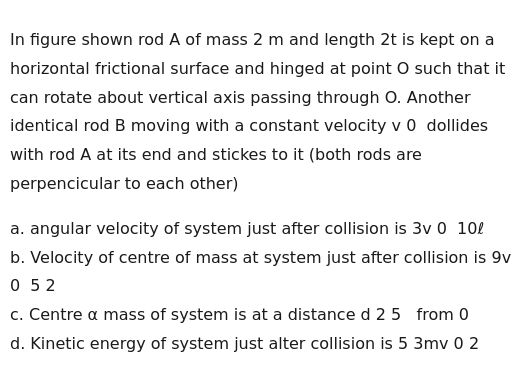Question
Question: In figure shown rod A of mass 2 m and length 2t is kept on a horizontal frictional surface and hinge...
In figure shown rod A of mass 2 m and length 2t is kept on a horizontal frictional surface and hinged at point O such that it can rotate about vertical axis passing through O. Another identical rod B moving with a constant velocity v 0 dollides with rod A at its end and stickes to it (both rods are perpencicular to each other)

angular velocity of system just after collision is 3v 0 10ℓ
Velocity of centre of mass at system just after collision is 9v 0 5 2
Centre α mass of system is at a distance d 2 5 from 0
Kinetic energy of system just alter collision is 5 3mv 0 2
Options (A) and (D)
Solution
Solution:
We use conservation of angular momentum about the hinge point O. In the collision only rod B contributes initial angular momentum about O. By computing the rotational inertias of the two rods (with rod A of mass 2m and length 2L having
IA=31(2m)(2L)2=38mL2
and rod B (identical in dimensions, mass 2m) having
IB=332mL2,
so that
Itotal=38mL2+332mL2=340mL2,
and taking the effective lever‐arm for rod B (its centre of mass lies at (2L, L) relative to O) so that its angular momentum is
LB=4mLV0,
equating initial angular momentum 4mLV0 to Itotalω we get
ω=10L3V0.
The rotational kinetic energy after collision is then
KE=21Itotalω2=21(340mL2)(10L3V0)2=53mV02.
Thus, the correct choices are the ones stating that the angular velocity is 10L3V0 and the kinetic energy is 53mV02.
